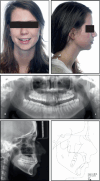Long-Term Follow-Up of Multiple Autotransplantations Combined With Orthodontic Treatment After Traumatic Dental Injury: A Case Report
- PMID: 40520568
- PMCID: PMC12163219
- DOI: 10.1155/crid/7098948
Long-Term Follow-Up of Multiple Autotransplantations Combined With Orthodontic Treatment After Traumatic Dental Injury: A Case Report
Abstract
In this case report, we present the treatment of an adult patient who had experienced dental trauma resulting in the loss of one tooth and damage to two others. The patient was referred to our clinic 4 years after the accident, where a comprehensive examination revealed external root resorption and loss of supporting tissue. To address the patient's concerns, we developed an interdisciplinary treatment plan, which included orthodontic treatment to level the curve of Spee, reduce the deep bite, and extrude the affected teeth. After that, we extracted the damaged Teeth 2.1 and 2.2 due to their poor prognosis and replaced them with autotransplantation of Teeth 1.4 and 3.1. Before the procedure, both teeth underwent endodontic treatment, and 6 weeks later, they were built up to aesthetically and functionally replace the lost teeth. Additionally, postautotransplantation orthodontic treatment was conducted to close the donor site space and bring the autotransplanted teeth to an ideal position. The interdisciplinary approach and successful treatment of this case suggest that autotransplantation can be a valid option for restoring compromised teeth, especially in adult patients who require orthodontic treatment. In conclusion, autotransplantation offers multiple benefits, including preserving the natural dentition, avoiding the use of dental implants or prostheses, and achieving excellent aesthetic and functional results. Furthermore, this case underscores the importance of individualized treatment planning and collaboration among dental specialists to achieve optimal outcomes for patients.
Keywords: autotransplantation; case report; dental traumatology; multidisciplinary treatment; orthodontic treatment.
Copyright © 2025 Johan Willem Booij et al. Case Reports in Dentistry published by John Wiley & Sons Ltd.
Conflict of interest statement
The authors declare no conflicts of interest.
Figures















Similar articles
-
Autotransplantation: A biological treatment alternative for a patient after traumatic dental injury.Korean J Orthod. 2018 Mar;48(2):125-130. doi: 10.4041/kjod.2018.48.2.125. Epub 2018 Feb 6. Korean J Orthod. 2018. PMID: 29564222 Free PMC article.
-
Wisdom Tooth Autotransplantation for the Missing Maxillary Central Incisors Using a 3D-Printed Replica: A Case Report.Cureus. 2024 May 29;16(5):e61327. doi: 10.7759/cureus.61327. eCollection 2024 May. Cureus. 2024. PMID: 38947626 Free PMC article.
-
Retrospective study of 100 autotransplanted teeth with complete root formation and subsequent orthodontic treatment.Am J Orthod Dentofacial Orthop. 2015 Dec;148(6):982-9. doi: 10.1016/j.ajodo.2015.06.018. Am J Orthod Dentofacial Orthop. 2015. PMID: 26672704
-
Endodontic-orthodontic relationships: a review of integrated treatment planning challenges.Int Endod J. 1999 Sep;32(5):343-60. doi: 10.1046/j.1365-2591.1999.00252.x. Int Endod J. 1999. PMID: 10551108 Review.
-
In the dental implant era, why do we still bother saving teeth?Dent Traumatol. 2019 Dec;35(6):368-375. doi: 10.1111/edt.12492. Epub 2019 Oct 14. Dent Traumatol. 2019. PMID: 31132200 Review.
References
Publication types
LinkOut - more resources
Full Text Sources

